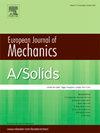一种用于机器人磨削振动控制的新型组合超材料的数据驱动优化设计
IF 4.2
2区 工程技术
Q1 MECHANICS
引用次数: 0
摘要
为了抑制机器人磨削中由于结构刚度低和点对点快速运动而产生的低频振动,提出了一种新型的组合机械超材料。两个余弦梁集成到先前开发的晶格中,并沿着负载方向对齐,在几何约束下实现近零负载条件。采用数据驱动的双目标优化算法,利用自适应约束最大化有效杨氏模量并定制带隙。训练双输出机器学习模型,分别预测带隙的上下边界。为了解决带隙跳跃引起的不连续问题,该模型结合了跳跃特征和目标加权损失,从而实现了稳定准确的预测。与原始晶格相比,优化后的超材料的有效杨氏模量增加了2.5倍(从150.34 Pa增加到374.38 Pa),第一个带隙下界减少(从18.33 Hz减少到9.47 Hz),带隙范围和带隙数量都增加了。进行了实验验证,表明最小振动传递值减少了大约一倍,从而证实了设计的有效性。所提供的高效和准确的数据驱动框架可能适用于超材料中两种性质的同时优化。本文章由计算机程序翻译,如有差异,请以英文原文为准。
Data-driven optimization design of a novel combined metamaterial for robotic grinding vibration control
In order to suppress low-frequency vibration induced by low structural stiffness and rapid point-to-point motion in robotic grinding, a novel combined mechanical metamaterial is proposed. Two cosine beams are integrated into a previously developed lattice and are aligned along the load direction, enabling near-zero load conditions within geometric constraints. A data-driven bi-objective optimization algorithm is applied, utilizing adaptive constraints to maximize effective Young's modulus and to tailor the band gap. A two-output machine learning model is trained to separately predict the upper and lower boundaries of the band gap. To address the discontinuity caused by band gap jumps, the model incorporates a jump feature and a target-weighted loss, thereby achieving stable and accurate predictions. Compared with the original lattice, the optimized metamaterial is shown to exhibit a 2.5-fold increase in effective Young's modulus (from 150.34 Pa to 374.38 Pa), a reduction in the lower bound of the first band gap (from 18.33 Hz to 9.47 Hz), and an expansion of both band gap range and count. Experimental validation is conducted, demonstrating an approximately double reduction in minimum vibration transmission values, thereby confirming the effectiveness of the design. The provided efficient and accurate data-driven framework is potentially applicable to the simultaneous optimization of two properties in metamaterials.
求助全文
通过发布文献求助,成功后即可免费获取论文全文。
去求助
来源期刊
CiteScore
7.00
自引率
7.30%
发文量
275
审稿时长
48 days
期刊介绍:
The European Journal of Mechanics endash; A/Solids continues to publish articles in English in all areas of Solid Mechanics from the physical and mathematical basis to materials engineering, technological applications and methods of modern computational mechanics, both pure and applied research.

 求助内容:
求助内容: 应助结果提醒方式:
应助结果提醒方式:


